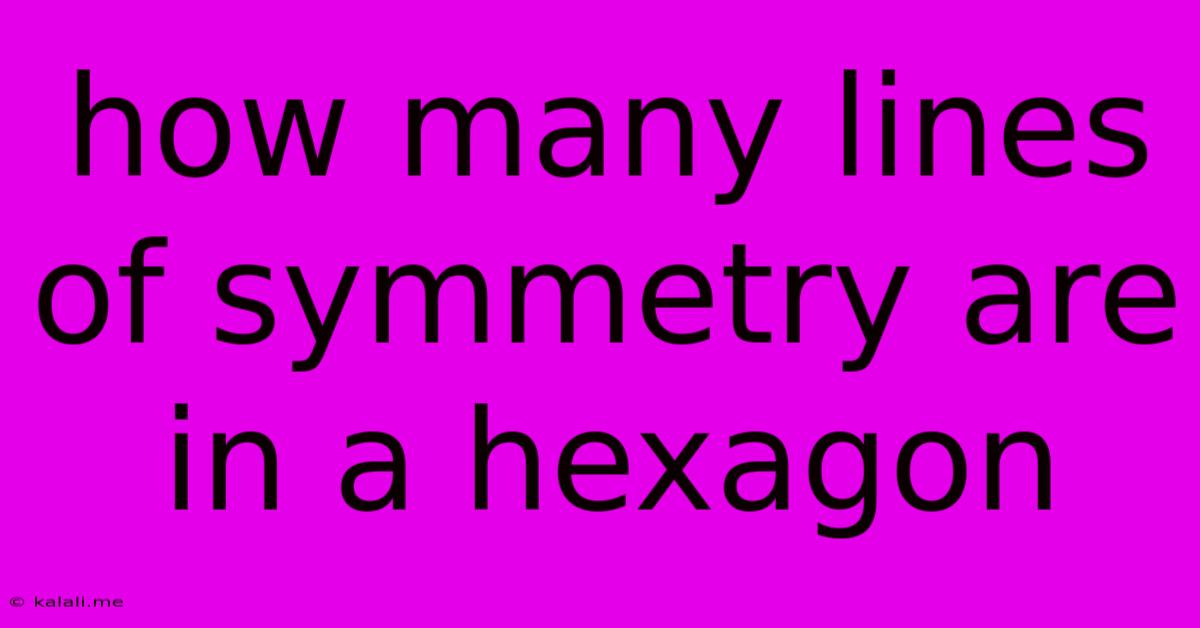How Many Lines Of Symmetry Are In A Hexagon
Kalali
May 09, 2025 · 3 min read

Table of Contents
How Many Lines of Symmetry Does a Hexagon Have? A Comprehensive Guide
Meta Description: Discover the number of lines of symmetry in a regular hexagon and explore the different types of hexagons and their symmetry properties. Learn about rotational symmetry and reflectional symmetry in this comprehensive guide.
A hexagon is a polygon with six sides. The number of lines of symmetry a hexagon possesses depends on whether it's a regular hexagon or an irregular hexagon. This article will delve into the specifics of each, explaining the concept of symmetry and how to determine the number of lines of symmetry for different shapes.
Understanding Lines of Symmetry
A line of symmetry, also known as a line of reflection, divides a shape into two identical halves that are mirror images of each other. If you were to fold the shape along the line of symmetry, both halves would perfectly overlap.
Lines of Symmetry in a Regular Hexagon
A regular hexagon is a hexagon with all sides and angles equal. It possesses a high degree of symmetry. Let's explore:
-
Reflectional Symmetry: A regular hexagon has six lines of symmetry. Three of these lines connect opposite vertices (corners), and three connect the midpoints of opposite sides. Imagine folding a regular hexagon along any of these six lines – the two halves will perfectly match.
-
Rotational Symmetry: Beyond lines of symmetry, regular hexagons also exhibit rotational symmetry. This means they can be rotated around their center point by certain angles (multiples of 60°) and still look identical. This adds another layer to the overall symmetry of the shape.
Visualizing the Lines of Symmetry: It's helpful to visualize a regular hexagon and draw lines through it to identify the lines of symmetry. You'll find three lines connecting opposite vertices and three lines connecting midpoints of opposite sides.
Lines of Symmetry in Irregular Hexagons
An irregular hexagon has sides and angles of different lengths and measures. Unlike regular hexagons, irregular hexagons typically have zero or fewer lines of symmetry. This is because the lack of uniformity prevents the creation of mirror-image halves. While some irregular hexagons might possess one or two lines of symmetry due to specific arrangements of their sides and angles, this is not a common occurrence.
Symmetry in Other Polygons
Understanding the symmetry of a hexagon can help you understand the symmetry of other polygons. The number of lines of symmetry often relates to the number of sides, but this is only true for regular polygons. For example:
- Equilateral Triangle: 3 lines of symmetry
- Square: 4 lines of symmetry
- Regular Pentagon: 5 lines of symmetry
- Regular Octagon: 8 lines of symmetry
The pattern is clear: a regular polygon with n sides has n lines of symmetry.
Conclusion
The number of lines of symmetry in a hexagon depends entirely on whether it's a regular or irregular hexagon. A regular hexagon boasts six lines of symmetry, while irregular hexagons typically have zero or very few. Understanding lines of symmetry is fundamental to geometry and helps in appreciating the visual properties of shapes. This knowledge extends to understanding symmetry in various other geometric figures and objects found in the world around us.
Latest Posts
Latest Posts
-
What Particles Are Located In The Nucleus
May 09, 2025
-
How Many Edges Does A Rectangular Prism Has
May 09, 2025
-
What Is 1 3 Of A Gallon
May 09, 2025
-
How Much Is 47 Cm In Inches
May 09, 2025
-
How To Find The Upper Class Limit
May 09, 2025
Related Post
Thank you for visiting our website which covers about How Many Lines Of Symmetry Are In A Hexagon . We hope the information provided has been useful to you. Feel free to contact us if you have any questions or need further assistance. See you next time and don't miss to bookmark.